Kartik M. Varadarajan
Improved Diagnosis of Tibiofemoral Cartilage Defects on MRI Images Using Deep Learning
Nov 30, 2020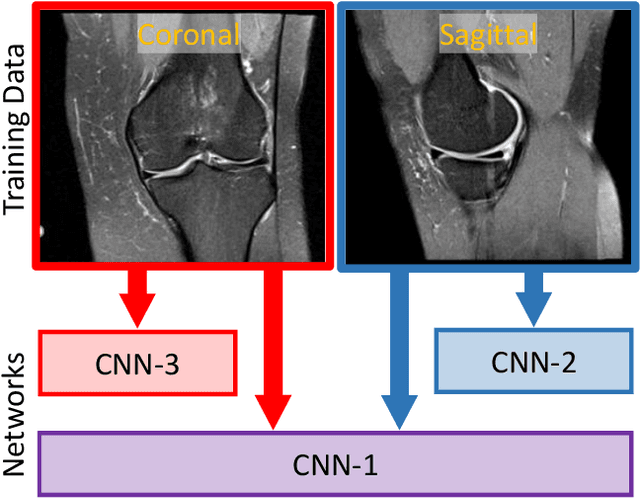
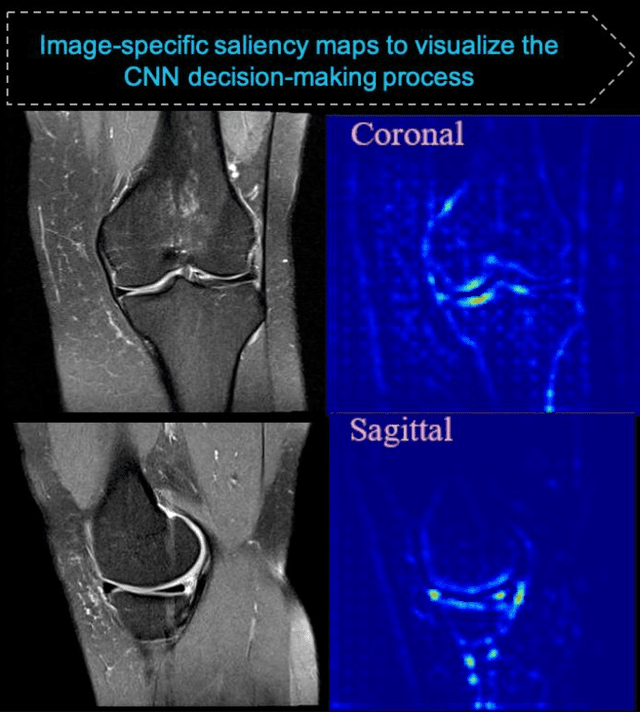
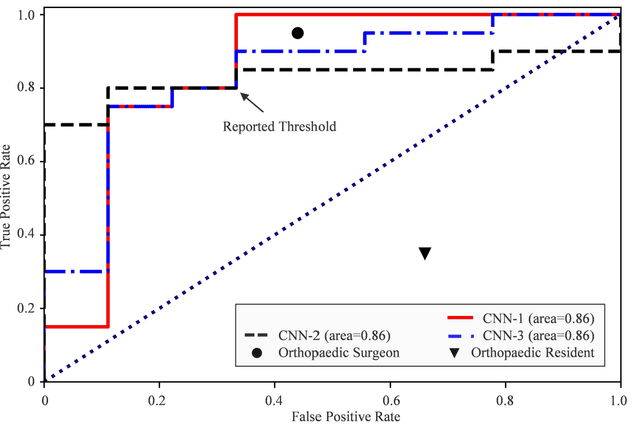
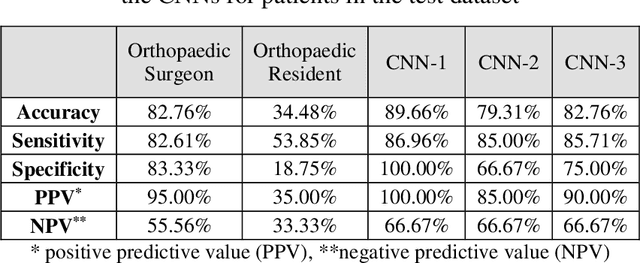
Abstract:Background: MRI is the modality of choice for cartilage imaging; however, its diagnostic performance is variable and significantly lower than the gold standard diagnostic knee arthroscopy. In recent years, deep learning has been used to automatically interpret medical images to improve diagnostic accuracy and speed. Purpose: The primary purpose of this study was to evaluate whether deep learning applied to the interpretation of knee MRI images can be utilized to identify cartilage defects accurately. Methods: We analyzed data from patients who underwent knee MRI evaluation and consequently had arthroscopic knee surgery (207 with cartilage defect, 90 without cartilage defect). Patients' arthroscopic findings were compared to preoperative MRI images to verify the presence or absence of isolated tibiofemoral cartilage defects. We developed three convolutional neural networks (CNNs) to analyze the MRI images and implemented image-specific saliency maps to visualize the CNNs' decision-making process. To compare the CNNs' performance against human interpretation, the same test dataset images were provided to an experienced orthopaedic surgeon and an orthopaedic resident. Results: Saliency maps demonstrated that the CNNs learned to focus on the clinically relevant areas of the tibiofemoral articular cartilage on MRI images during the decision-making processes. One CNN achieved higher performance than the orthopaedic surgeon, with two more accurate diagnoses made by the CNN. All the CNNs outperformed the orthopaedic resident. Conclusion: CNN can be used to enhance the diagnostic performance of MRI in identifying isolated tibiofemoral cartilage defects and may replace diagnostic knee arthroscopy in certain cases in the future.
Natural Language Processing with Deep Learning for Medical Adverse Event Detection from Free-Text Medical Narratives: A Case Study of Detecting Total Hip Replacement Dislocation
Apr 26, 2020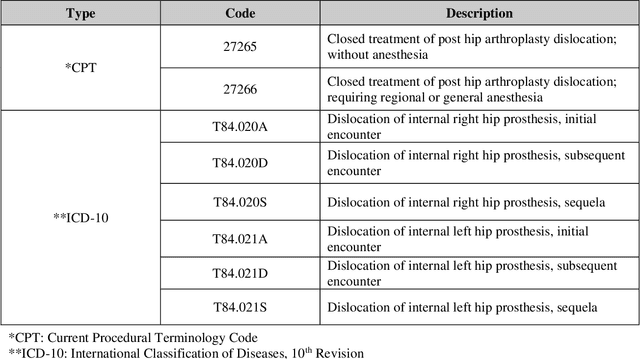

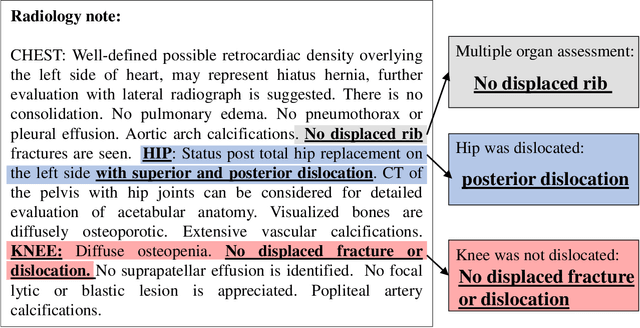
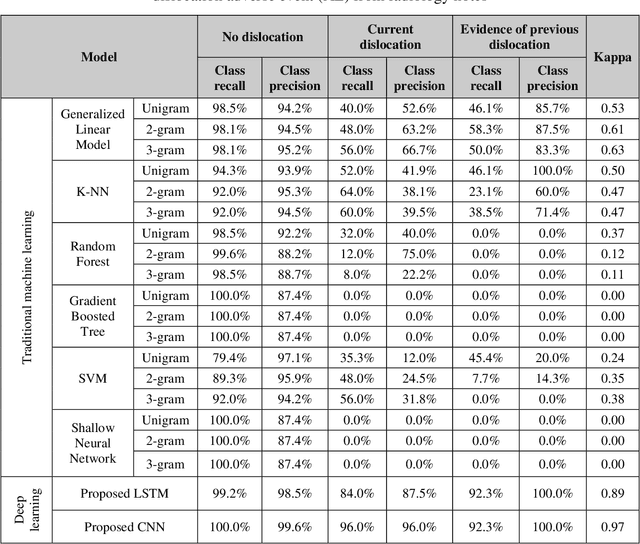
Abstract:Accurate and timely detection of medical adverse events (AEs) from free-text medical narratives is challenging. Natural language processing (NLP) with deep learning has already shown great potential for analyzing free-text data, but its application for medical AE detection has been limited. In this study we proposed deep learning based NLP (DL-NLP) models for efficient and accurate hip dislocation AE detection following total hip replacement from standard (radiology notes) and non-standard (follow-up telephone notes) free-text medical narratives. We benchmarked these proposed models with a wide variety of traditional machine learning based NLP (ML-NLP) models, and also assessed the accuracy of International Classification of Diseases (ICD) and Current Procedural Terminology (CPT) codes in capturing these hip dislocation AEs in a multi-center orthopaedic registry. All DL-NLP models out-performed all of the ML-NLP models, with a convolutional neural network (CNN) model achieving the best overall performance (Kappa = 0.97 for radiology notes, and Kappa = 1.00 for follow-up telephone notes). On the other hand, the ICD/CPT codes of the patients who sustained a hip dislocation AE were only 75.24% accurate, showing the potential of the proposed model to be used in largescale orthopaedic registries for accurate and efficient hip dislocation AE detection to improve the quality of care and patient outcome.
Detecting mechanical loosening of total hip replacement implant from plain radiograph using deep convolutional neural network
Dec 02, 2019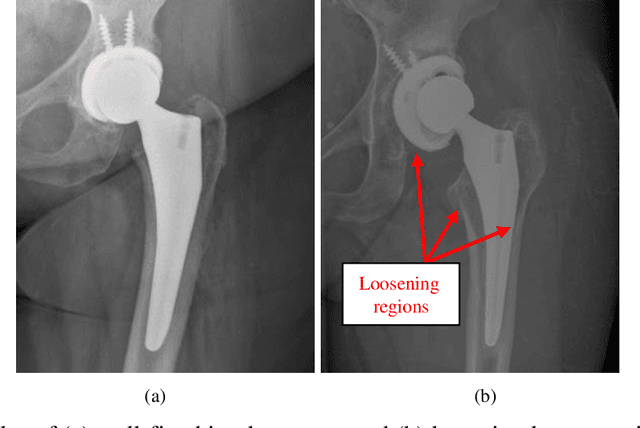
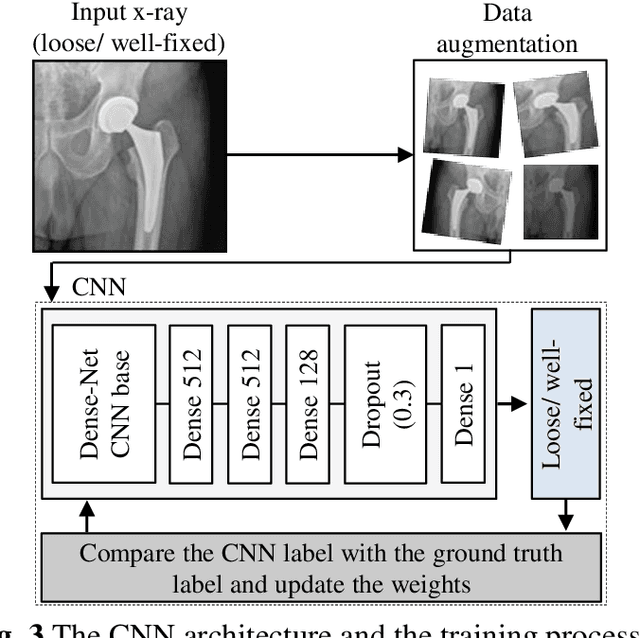
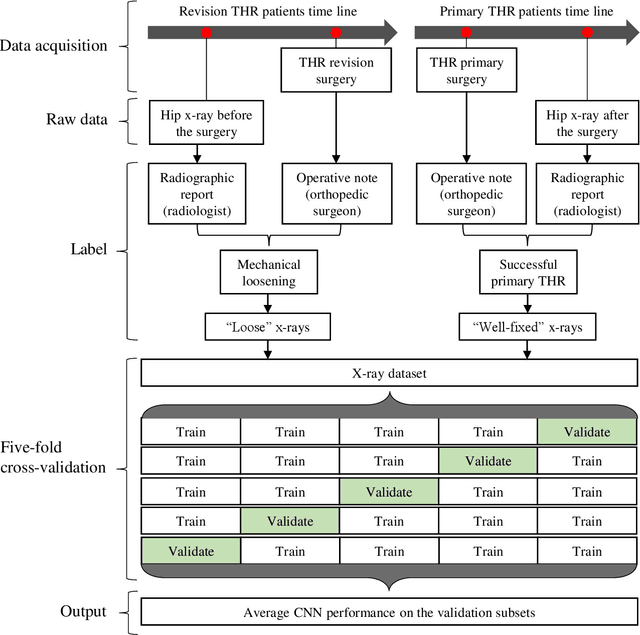
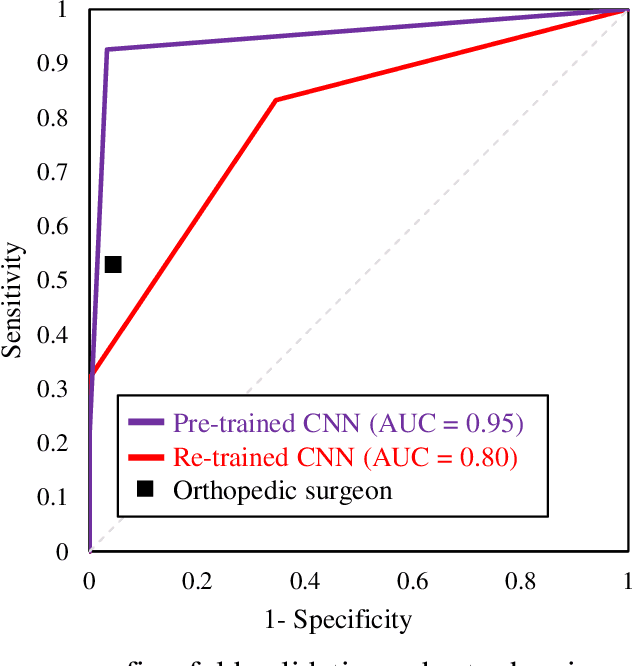
Abstract:Plain radiography is widely used to detect mechanical loosening of total hip replacement (THR) implants. Currently, radiographs are assessed manually by medical professionals, which may be prone to poor inter and intra observer reliability and low accuracy. Furthermore, manual detection of mechanical loosening of THR implants requires experienced clinicians who might not always be readily available, potentially resulting in delayed diagnosis. In this study, we present a novel, fully automatic and interpretable approach to detect mechanical loosening of THR implants from plain radiographs using deep convolutional neural network (CNN). We trained a CNN on 40 patients anteroposterior hip x rays using five fold cross validation and compared its performance with a high volume board certified orthopaedic surgeon (AFC). To increase the confidence in the machine outcome, we also implemented saliency maps to visualize where the CNN looked at to make a diagnosis. CNN outperformed the orthopaedic surgeon in diagnosing mechanical loosening of THR implants achieving significantly higher sensitively (0.94) than the orthopaedic surgeon (0.53) with the same specificity (0.96). The saliency maps showed that the CNN looked at clinically relevant features to make a diagnosis. Such CNNs can be used for automatic radiologic assessment of mechanical loosening of THR implants to supplement the practitioners decision making process, increasing their diagnostic accuracy, and freeing them to engage in more patient centric care.
Detecting total hip replacement prosthesis design on preoperative radiographs using deep convolutional neural network
Nov 27, 2019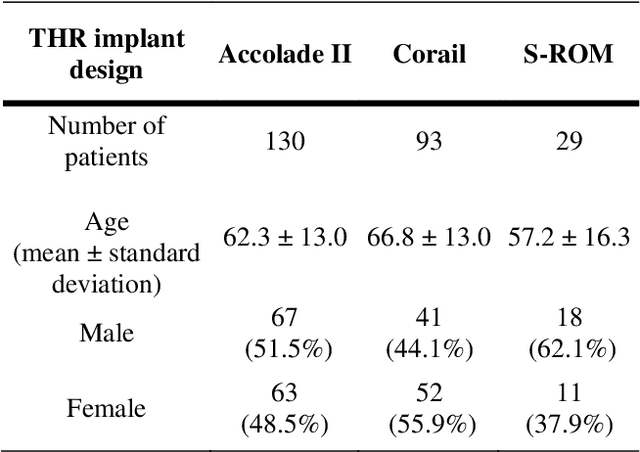
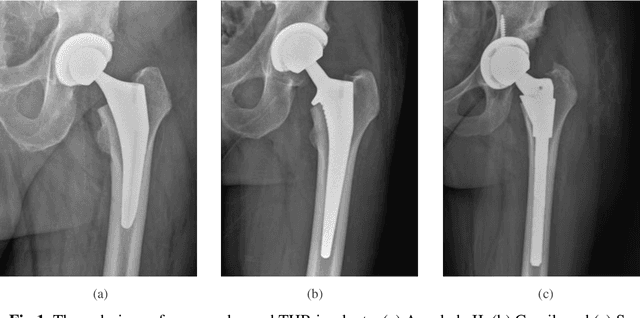
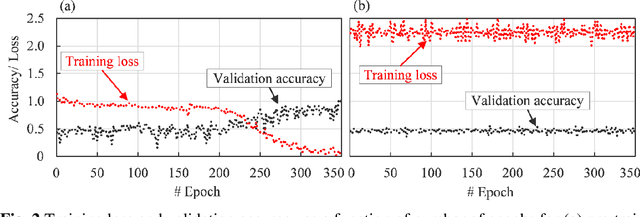
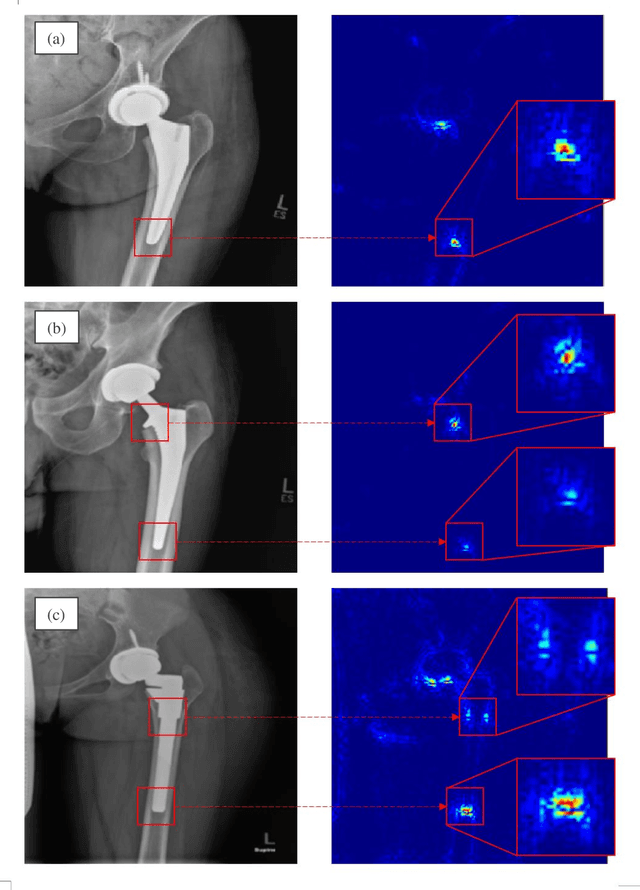
Abstract:Identifying the design of a failed implant is a key step in preoperative planning of revision total joint arthroplasty. Manual identification of the implant design from radiographic images is time consuming and prone to error. Failure to identify the implant design preoperatively can lead to increased operating room time, more complex surgery, increased blood loss, increased bone loss, increased recovery time, and overall increased healthcare costs. In this study, we present a novel, fully automatic and interpretable approach to identify the design of total hip replacement (THR) implants from plain radiographs using deep convolutional neural network (CNN). CNN achieved 100% accuracy in identification of three commonly used THR implant designs. Such CNN can be used to automatically identify the design of a failed THR implant preoperatively in just a few seconds, saving time and improving the identification accuracy. This can potentially improve patient outcomes, free practitioners time, and reduce healthcare costs.
 Add to Chrome
Add to Chrome Add to Firefox
Add to Firefox Add to Edge
Add to Edge